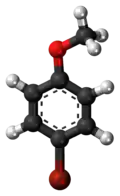4-Bromoanisole
4-Bromoanisole is the organobromine compound with the formula CH3OC6H4Br. It is colorless liquid with a pleasant smell similar to that of anise seed. It is one of three isomers of bromoanisole, the others being 3-bromoanisole and 2-bromoanisole. It is the precursor to many 4-anisyl derivatives.
| |||
| Names | |||
|---|---|---|---|
| Preferred IUPAC name
1-Bromo-4-methoxybenzene | |||
| Other names
4-Bromoanisole; para-Bromoanisole; p-Bromoanisole | |||
| Identifiers | |||
3D model (JSmol) |
|||
| ChEBI | |||
| ChemSpider | |||
| ECHA InfoCard | 100.002.957 | ||
PubChem CID |
|||
| UNII | |||
CompTox Dashboard (EPA) |
|||
| |||
| |||
| Properties | |||
| C7H7BrO | |||
| Molar mass | 187.036 g·mol−1 | ||
| Density | 1.49 g/ml | ||
| Melting point | 10 °C (50 °F; 283 K) | ||
| Boiling point | 223 °C (433 °F; 496 K) | ||
Except where otherwise noted, data are given for materials in their standard state (at 25 °C [77 °F], 100 kPa). | |||
| Infobox references | |||
Reactions and uses
4-Bromoanisole forms a Grignard reagent,[1] which reacts with phosphorus trichloride to give tris(4-methoxyphenyl)phosphine:
- 3 CH3OC6H4MgBr + PCl3 → (CH3OC6H4)3P + 3 MgBrCl
4-Bromoanisole forms the organozinc derivative CH3OC6H4ZnBr.[2]
4-Bromoanisole is compound sometimes used in RNA extraction which serves to further eliminate DNA contamination.[3] It interacts with genomic DNA (gDNA) and through a separation phase, it will be located in the organic layer instead of the aqueous layer (upper layer) containing the RNA extract.[4]
See also
References
- Stille, J. K.; Echavarren, Antonio M.; Williams, Robert M.; Hendrix, James A. (1993). "4-Methoxy-4'-Nitrobiphenyl". Organic Syntheses. 71: 97. doi:10.15227/orgsyn.071.0097.
- Le Gall, Erwan; Martens, Thierry (2012). "Multicomponent Synthesis of Tertiary Diarylmethylamines: 1-((4-Fluorophenyl)(4-methoxyphenyl)methyl)piperidine". Organic Syntheses. 89: 283. doi:10.15227/orgsyn.089.0283.
- "NAzol RT" (PDF). mrcgene.com. March 2017. Retrieved September 20, 2019.
- Khoury, Samantha; Ajuyah, Pamela; Tran, Nham (2014). "Isolation of Small Noncoding RNAs from Human Serum". Journal of Visualized Experiments (88): 51443. doi:10.3791/51443. PMC 4195580. PMID 24998448.

